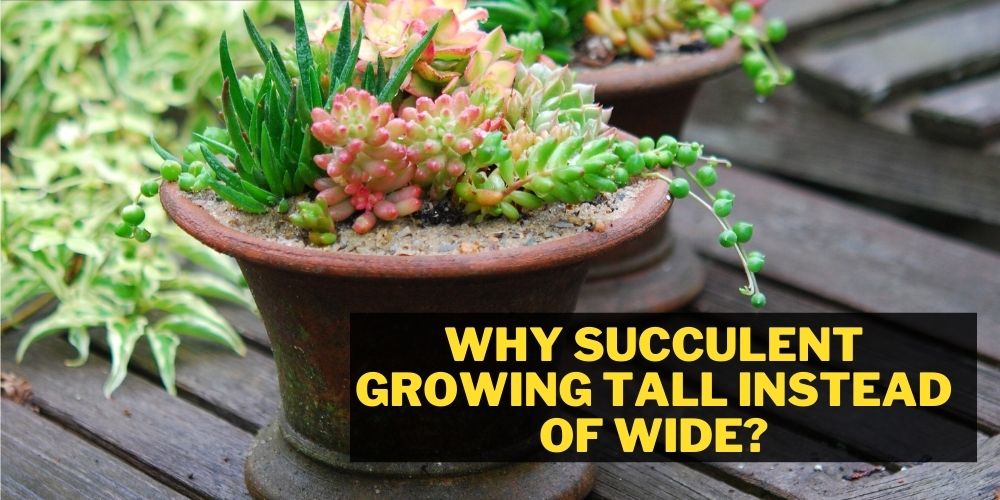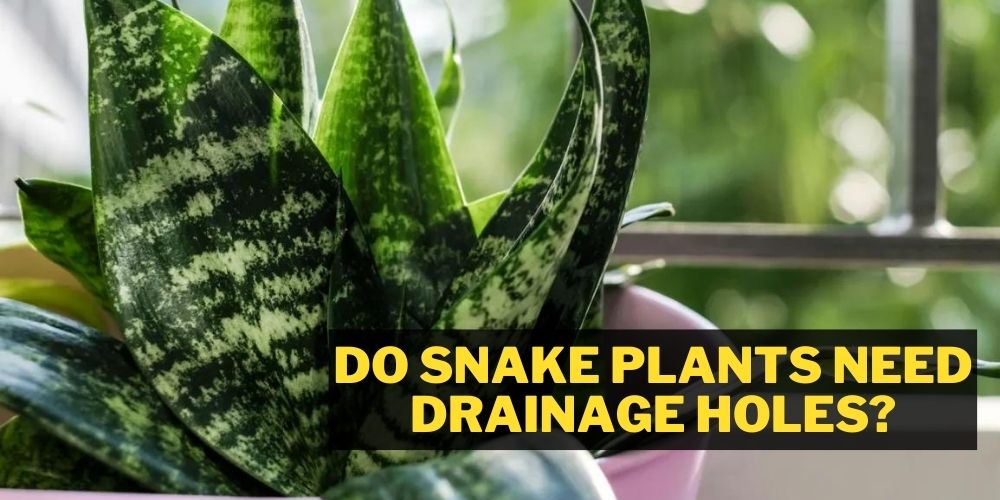Succulents are fast becoming an extremely popular choice of plant for garden lovers. These wonderfully convenient patches of greenery are a satisfying addition to indoor and outdoor settings. They not only look great, but they are also quite easy to maintain and hard to kill.
But, do succulents get bigger as well?
Well, if you provide perfect growing conditions then some succulents can get bigger with age. But there are a few succulent types who can’t get bigger even in proper growing conditions.
Being the joy-bringing plants that they are, one key piece of information must be understood is the importance of the scope of growth for a succulent. If your plant isn’t maintained correctly, what is seen as a decorative plant could get beyond control. For example, some plants, like the Haworthia, can grow indefinitely and quickly.
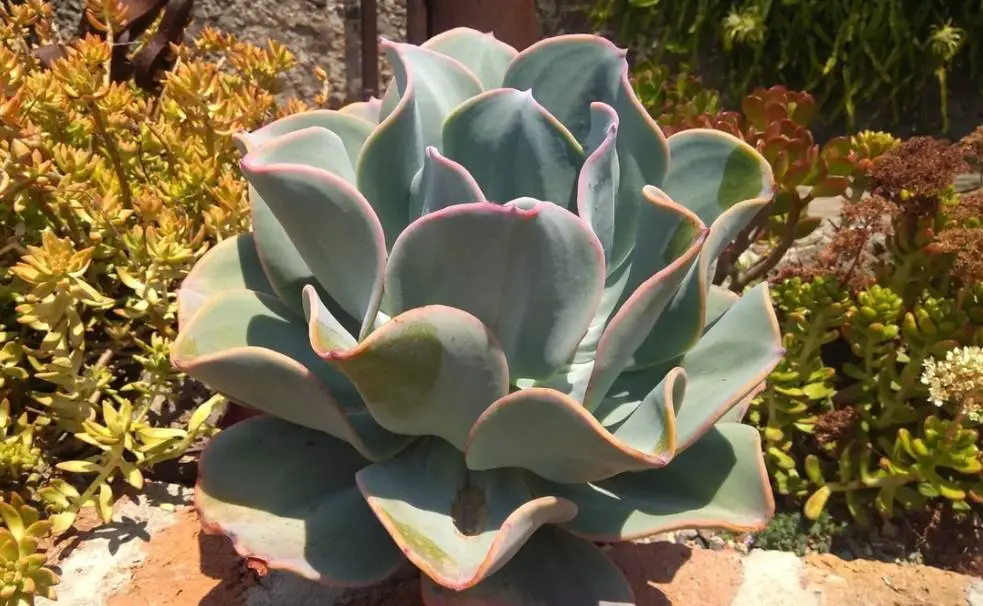
If a succulent is planted in a sunny spot with well-drained soil, it has almost all the elements it needs to grow wild and crazy. Our detailed research on this topic aims to help those concerned about decorating their space with their favorite succulent.
Table of Contents
Do Succulents Get Bigger? The Actual Answer
There has been much debate on this topic within the garden community, but the short and sweet answer is yes and no!
The myth has always been that succulents are small and stay small, but that’s not the case. Many aspects can help or hinder the growth and/or overall size of a succulent.
The biggest takeaway is that succulents are, in fact, just like normal plants; their species’ can also come in a wide range of shapes and sizes. So yes, they do get bigger, given they have optimal growing conditions. The no is more related to the that many small species of succulents don’t grow so large.
Another luring factor is that it’s quite common to see smaller succulents around, which creates a misconception as to if they grow bigger or not. They are often sold small and set up in smaller arrangements for decorative purposes.
Surprisingly, the average size of most types of succulents is between 6 inches and 2 feet tall when fully grown. Some varieties, such as Jade Plant or Elephant Bush, can grow as much as 8 feet!
How big can a succulent get? Do They Overgrow?
Succulents are deceptively tall as they reach full growth. Some species are dwarfed by other larger variants, which reach anywhere upto 2 feet in size. This doesn’t consider the fact that they can become extremely overgrown.
The more they spread out, the tougher it is to keep them under control. So not only do they grow up, but they also grow out. One of the biggest issues is the complacency that a succulent owner can fall into, which can see a plant go wild.
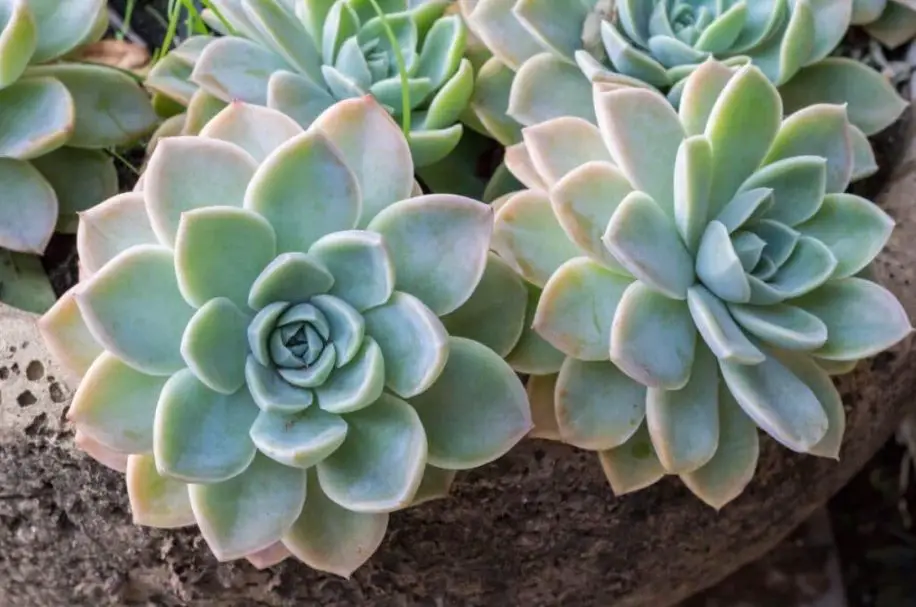
Succulents are often seen as easy maintenance, which is true because they require little water. This factor can often make the owner disregard the plant, as watering is a regular part of plant maintenance. All of a sudden, ignorance can create some real headaches.
Factors that affect How Big Succulents Get:
Several factors affect the size of a succulent plant, and some only play minor parts, while others can give them a boost. Regardless of which one does what, they all contribute to their role in tandem to create optimal growing conditions for a succulent plant.
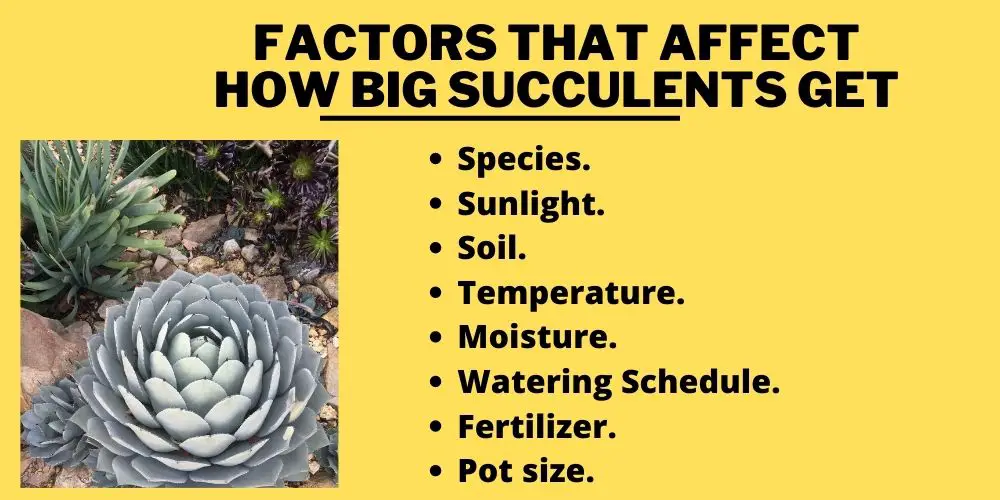
Species
Like normal plants (that aren’t succulents), there is a huge range of different species that can vary in shape and size. Some succulent species, like the Flower Dust Plant or Lithops, can be quite small and don’t grow any bigger than 1.5 inches.
On the other end of the spectrum, there are succulents such as Copper Pinwheel (16 inches) or African Baobab, which can reach upto a mammoth 82 feet tall! The latter is the tallest known succulent.
Sunlight
Most succulents love sunlight, but some enjoy the rays more than others. 4-6 hours of direct sunlight per day is optimal. There’s a species called the Rhipsalis which can be found naturally in small gaps amongst trees instead of soil.
This particular species prefers more filtered sunlight, emulating its growing conditions in the wild. Then there are species such as Opuntia and Cereus which enjoy full sun. They are found in the desert in conditions that offer minimal shade. So naturally, they have needed to adapt to conditions that don’t give any respite from the heat.
Soil
Soil has a huge impact on the growth of a succulent. Like other plants, succulents get their ‘food’ from nutrients from the soil they grow in. That being said, succulents need good quality soil with all the right nutrients to give them the extra boost they need to thrive.
Well-draining soil with minimal clay or organic material is ideal for optimal growth. The clay and organic material will hold the water, which as a result causes root rot and untimely death of the plant. Sand, gravel and perlite, on the other hand, are a great choice as they offer good drainage and filtration.
Temperature
We touched on sunlight already, but temperature as a whole is another defining factor that can affect a succulent’s ability to grow. Generally speaking, these variants of plants don’t fare too well in colder conditions. Especially when frost starts to set in or it gets below freezing point.
On the other hand, succulents have a stigma attached to them because they seemingly love extreme heat. But for a lot of species, though, that’s just not the case. They can dry right out and die if not offered any respite from the harsher heat.
We’re talking about homegrown succulents here. The ones found in their natural environment can take a little bit more heat. Most plants of this type enjoy temperatures of between 50-90°F (10-32°C)
Moisture
Moisture in the form of humidity can cause headaches for your succulents, especially if they are predominantly grown somewhere like a bathroom. Humidity is the amount of water vapor found in the air, and the heat can cause the water to evaporate, causing high humidity levels.
Succulents can adapt to this humidity, but not all species can thrive in an environment like this for too long. The survival of these plants relies on the thickness of their leaves and their adaptability to humid conditions. Those with thicker, more plump leaves can survive much longer than those with smaller, more vulnerable leaves.
Watering Schedule
As a beginner, it’s easy to mistake the amount of moisture a succulent requires. Overwatering can drown them out and cause root rot which leads to death. At the same time, underwatering can dry them out and stunt their growth or also see them live a short life.
Funnily enough, succulents are quite tolerant when it comes to dry conditions. This does not mean they don’t need water, though. Whatever you go, there is a risk of harming your plant if a proper watering schedule isn’t followed correctly.
Sometimes, a succulent won’t necessarily require too much water, especially through the colder months. They can go through what is known as ‘dormancy’, essentially periods of slow growth. Different species can tolerate more or less amounts and in specific frequencies.
As a rule of thumb, succulents should be watered once a week during growth periods. The frequency can be scaled back to every 2 weeks once fully established. A good sign that a succulent has enough water is when its leaves are plump and firm.
Fertilizer
When any plant gets the right nutrients into them, they are always going to thrive. Succulents are no different. They become healthier, fuller and form almost perfect plants in their growth periods.
They can deal with any external stressors much better also. Pests such as bugs and other insects won’t affect them as much. They will also tolerate weather conditions much better than they could without the extra nutritional support.
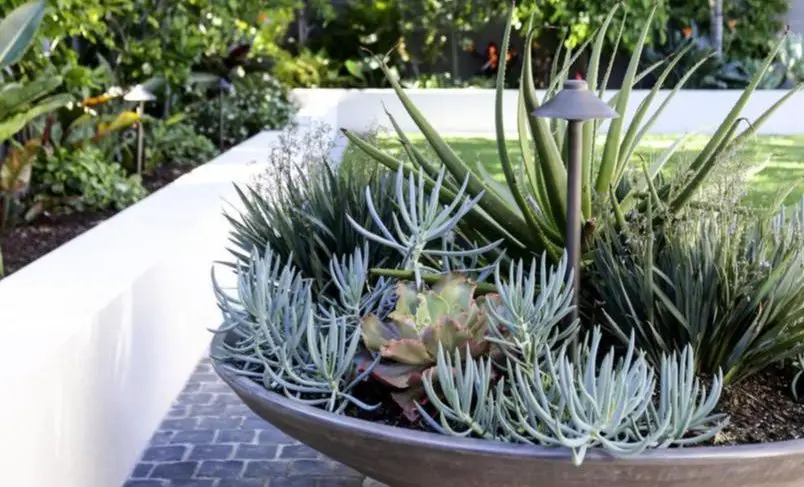
Pot size
Pot size is another important factor to consider. If a succulent stays in the same container for an extended period, the plant can slowly deplete the soil of important nutrients. This factor alone can lead to nutrient deficiency problems.
A visual sign of this issue is the yellowing of the top leaves. Insufficient nutrients can reduce the chances of succulents reaching maturity. Another reason pot size is important is allowing the plant to grow.
The roots can only fan out so much, so if the pot is small, the roots won’t be able to grow, which in turn stunts the growth of the succulent.
That said, succulents have a better opportunity to grow once repotted into a larger pot after they outgrow their original home. They can outgrow their growing container. Succulents may start to grow top-heavy and sway to either side. They can also sprout roots everywhere, which can also cause weight/swaying issues.
How big do succulents get indoors?
Succulents can grow up to 6-12 feet tall when planted and grown indoors. Again, it will all come down to which species of succulents are grown, and it will also depend on if the plant is given everything it requires to grow to that size.
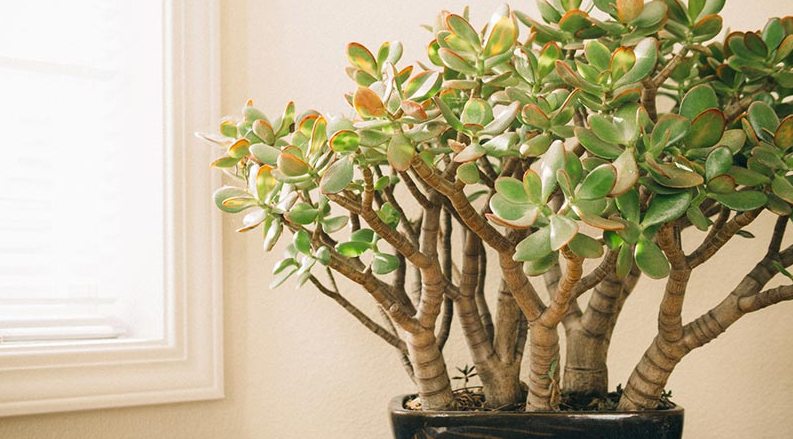
Adequate temperature, water schedule, nutrients, sunlight, and drainable soil can all contribute to the optimisation of a succulent plant. These plants are slow-growing, so sometimes, it feels as if they aren’t gaining any height. Succulents are not for anyone with a low patience threshold!
How big do succulents get outdoors?
When grown outdoors, a succulent usually maxes out at around 6 inches. Unlike those grown indoors, outdoor succulent growth size also depends on their species and ability to receive optimal growing conditions.
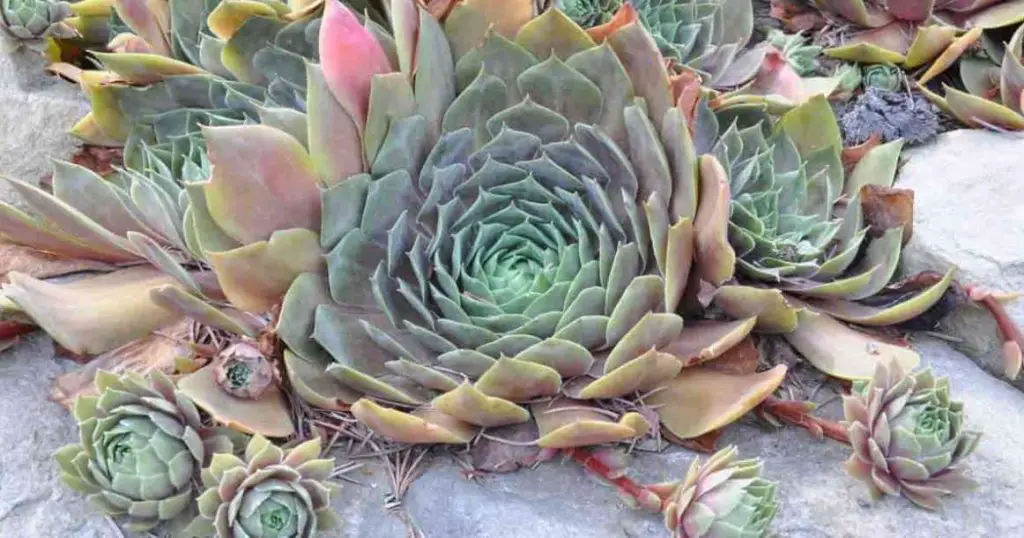
Outdoor succulents don’t grow as tall as the indoor variants, and this is due to more challenging weather, soil and nutrient conditions. Sunlight, drainable soil and water frequency are similar to those grown indoors.
Succulent size chart
Like any plant, succulents can also vary in size. There are many different species of succulents that fall into either the short or tall category. Whether for decorative purposes or even their amazing ability to purify the air in your home, succulents are just a beauty to own.
They are light-loving plants, and the light they receive helps them grow to their most perfect form. Here is a list and their characteristics to give you a better idea of choosing which would suit your needs.
Succulents that Grow Tall
Crassula Ovata (Jade Plant)
The stem and branches of the Jade plant can vary in thickness. They often start thicker from the base, moving upwards towards the top. The skin is rough and lightish brown.
The leaves are green and usually oval-shaped. The stems with leaves included can often grow up to 12 inches (30 cm) long. The whole plant, once fully grown, can max out at a whopping 15 feet (5 meters) tall.
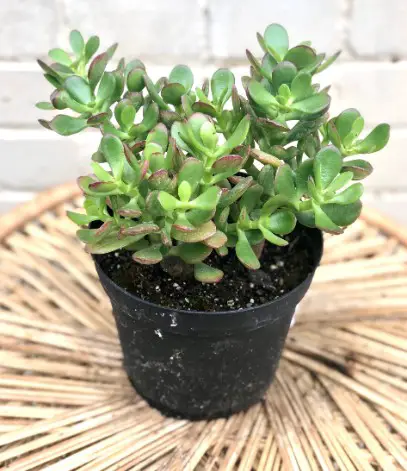
Kalanchoe Beharensis (Felt Bush, Elephant’s Ears)
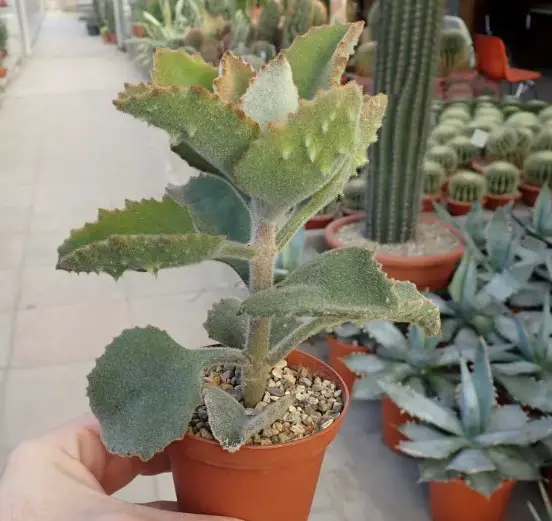
his succulent has an odd-looking similarity to that of an elephant’s ear. Hence the name. Its stems are usually long, and the leaves are mainly grown only at the top of the stem. The leaves are palish green in color.
This species of succulents can be found in the Kalahari Desert of South Africa. It is highly adaptive to extreme heat. The Kalanchoe Beharensis takes around 4 years to fully develop, and it can reach 16 feet (3.7 meters) tall. The lifespan of this succulent is 30 years!
Pachypodium Lamerei (Madagascar Palm)
This succulent could almost pass as a cactus with its tall, thin stem and bushy, spiky crown. The stems and branches can come in various colors such as pale brown, green, pink, purple, brown, white and yellow. The leaves are usually lush and green.
As the nodes grow, they form almost smaller trees at each node point, giving them an interesting look. The Pachypodium Lamerei can grow upto 20 feet (6m) in height. They require minimal watering.
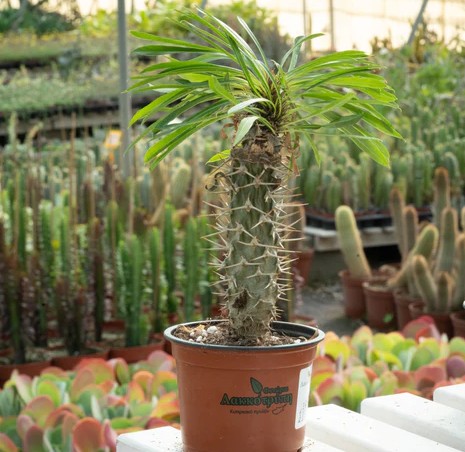
This succulent could almost pass as a cactus with its tall, thin stem and bushy, spiky crown. The stems and branches can come in various colors such as pale brown, green, pink, purple, brown, white and yellow. The leaves are usually lush and green. As the nodes grow, they form almost smaller trees at each node point, giving them an interesting look. The Pachypodium Lamerei can grow upto 20 feet (6m) in height. They require minimal watering.
Succulents that Stay Small
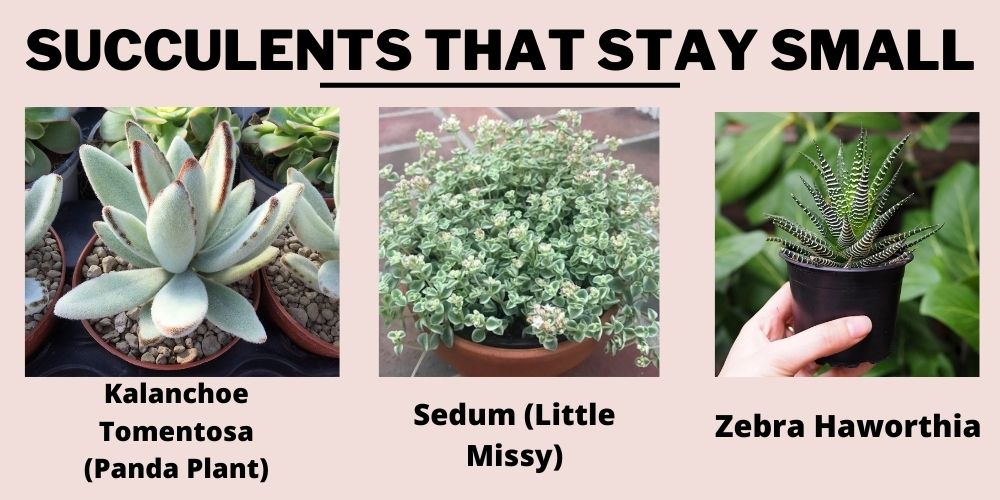
Kalanchoe Tomentosa (Panda Plant)
Panda plant is a beautiful small succulent with soft velvety leaves. They are generally thick, oval-shaped and grey/green in color. They can surprisingly grow up to 18 inches tall.
Sedum (Little Missy)
This succulent is best placed in the shade. Too much heat can kill it instantly. It has tiny stems and oval-shaped green/white leaves. They can also produce pink flowers in the summer. Sedum can grow to around 3 inches maximum, so it is a mini plant.
Zebra Haworthia
This succulent gets its name from the white bands staggered up its pointy green leaves. It is often mistaken for an aloe vera plant as its characteristics are similar. The leaves won’t reach above 6 inches, putting it in the small category.
How big do mini succulents get?
Mini succulents get their name from being just that, mini. They will not grow any taller than 6 inches. These little beauties are often pigeonholed as ‘Ikea mini succulents’ because that’s one of the only places where they are sold in abundance.
The most common place that a mini succulent calls home is in an office, on a desk, or as a decoration. They are easy to take care of and super cute!
How do I get my succulents to grow bigger?
As with any plant, a succulent is no different when assisting it through its vital growth stages. It will need all the key elements required for optimal growth. These include:
- Adequate sunlight – A succulent should get at least 4-6 hours of daily sunlight. The morning sun is much less harsh than the afternoon, where the plants can scald.
- Heat – Too much heat will do a lot of damage to succulents and won’t allow them to grow. They will use most of their moisture to cool themselves down as they can’t keep up with the heat. Succulents are known to go through dry periods, but excess heat is not good for their survival.
- Nutrients – Plant food is very important if you want to ensure your succulents grow big and strong. Nitrogen (N), Phosphorus (P) and Potassium (K) are the most important nutrients. These should be the perfect blend of what is known as the NPK ratio. Nitrogen helps with leaf growth, Phosphorus assists with root growth, and Potassium aids the photosynthesis process.
- Watering – Too much water will drown the plants out, causing root rot and killing them. Not enough water isn’t as big of an issue, but infrequent watering can dry them out and also cause them an early end to their life.
- Soil and drainage – Good quality soil is always essential for any plant. A succulent soil should contain a good mix of nutrients and drainage. The better the drainage, the less chance the plant has of forming root rot.
Once all of these factors are met, the succulents also require consistent maintenance. Regular pruning is a must; this encourages new growth and prevents the plant from becoming top-heavy and falling over. Also, repotting is ideal once the plant shows signs of cramming for space.
If the pot is too small, the roots will start to ball at the bottom and prevent optimal growth. Plants need space for their roots to grow, not only sideways but depth-wise also.
Frequently Asked Questions (FAQs)
How long does it take succulents to get bigger?
Succulents generally take around 1 month to grow to a point where the changes are quite visible. After 4-5 months, you should notice significant changes.
Do succulents multiply?
Succulents are known for their ability to multiply. They often produce little offshoots of new plants or nodes. These contain root systems but often don’t grow leaves until they have fully established themselves. These plants are easy to propagate from stem and leaf cuttings, which is the simplest way to multiply a succulent plant.
What is the largest succulent?
The largest known succulent is the Adansonia Digitata (African Baobab). These monsters can grow upto 16-82 feet tall (5–25 meters). To paint a picture, their trunks can reach a diameter of 33-46 ft (10–14 meters). They have been known to grow as old as 2,000 years, according to radiocarbon dating. They are usually found in the African continent and the Southern Arabian Peninsula in countries such as Yemen and Oman.
Conclusion:
As we can see, succulents do get bigger. They are the same as almost every other known species in how they grow. They require certain key elements to reach optimal growth stages.
If these elements aren’t met, they risk growth stunting and a range of other long-term issues. We hope this article has been informative, and we look forward to seeing you on the next one! Happy growing….bigger!

